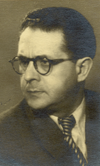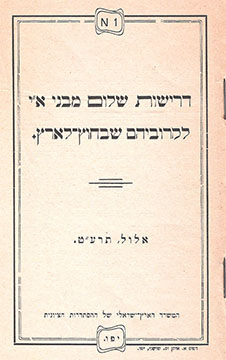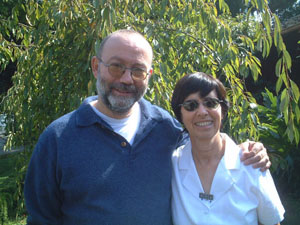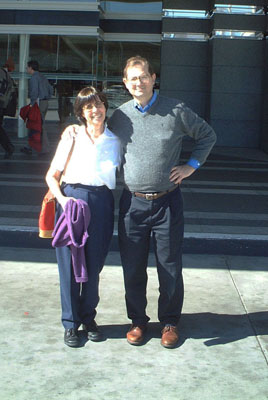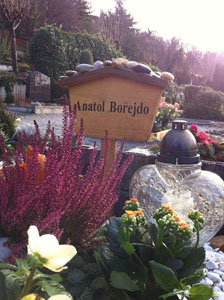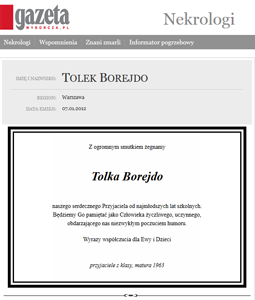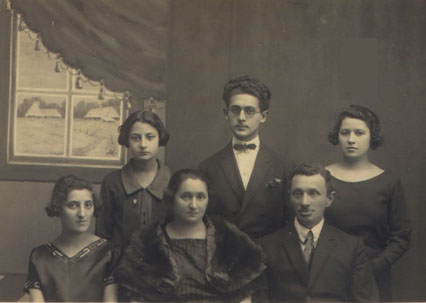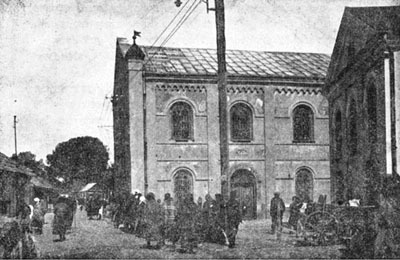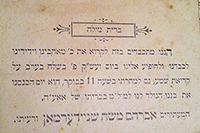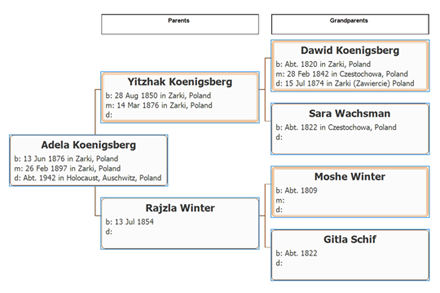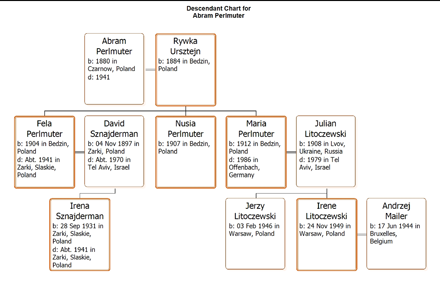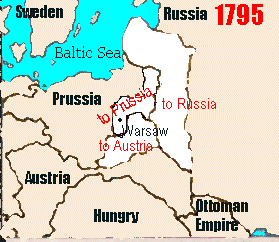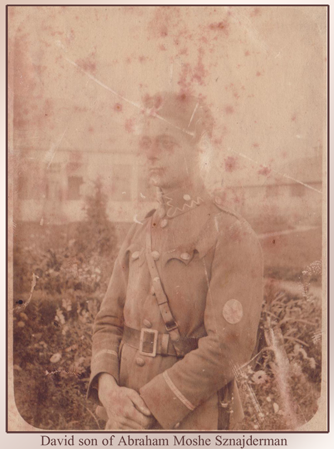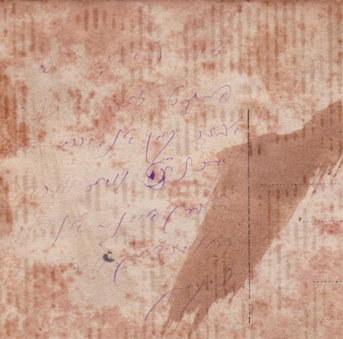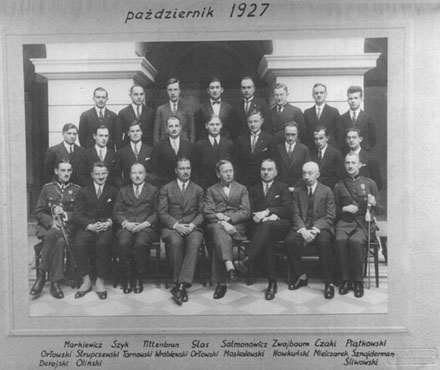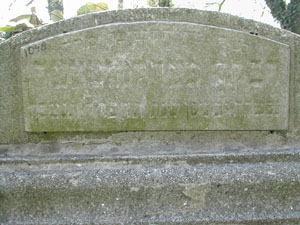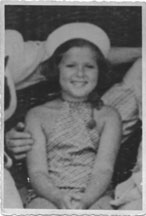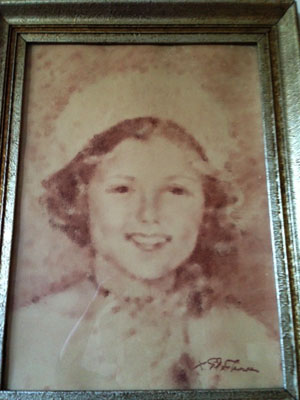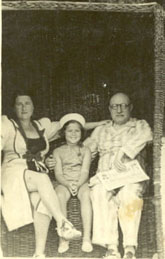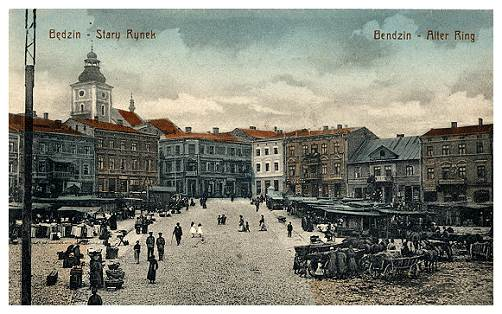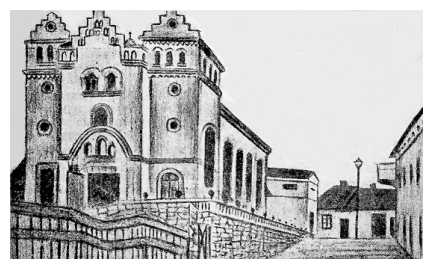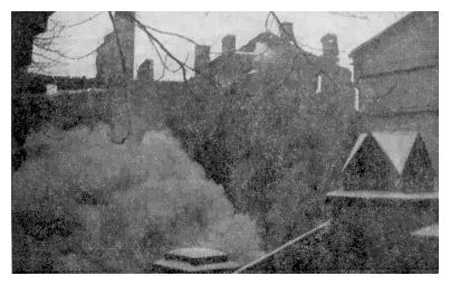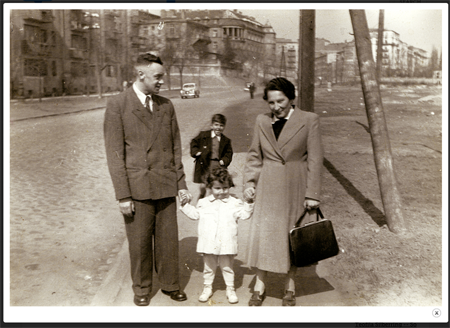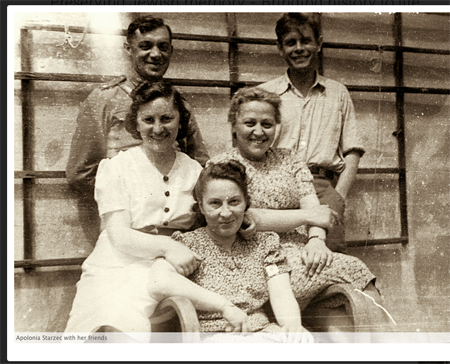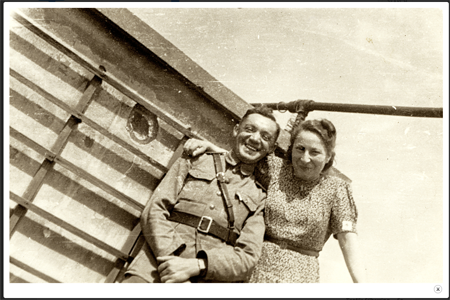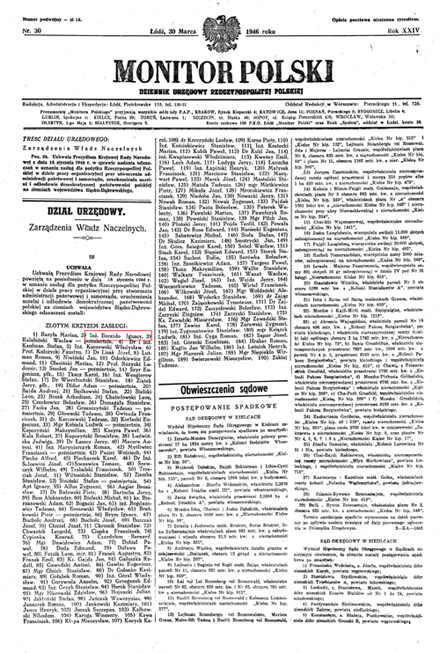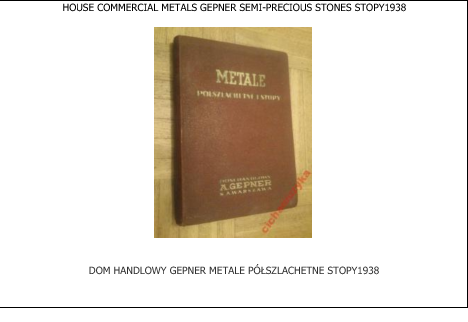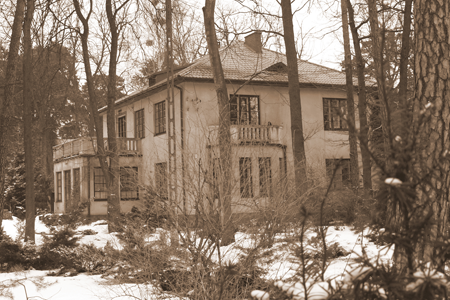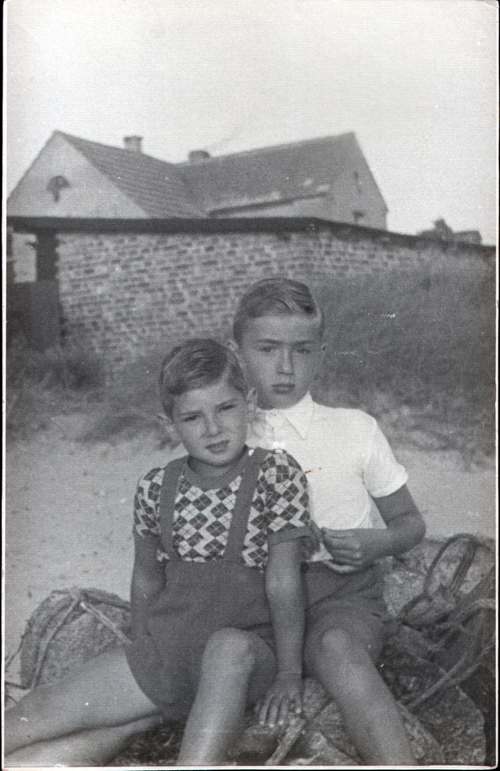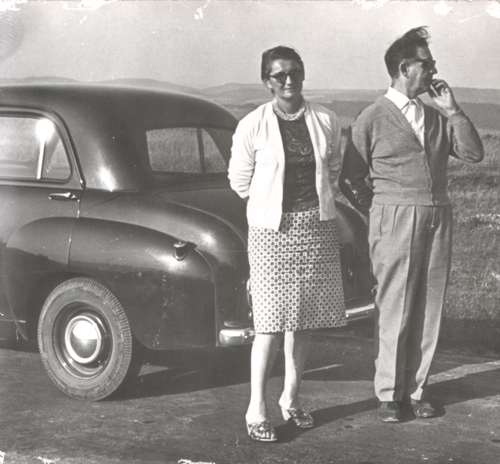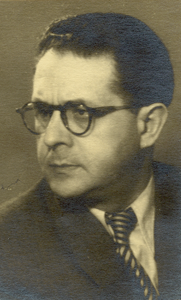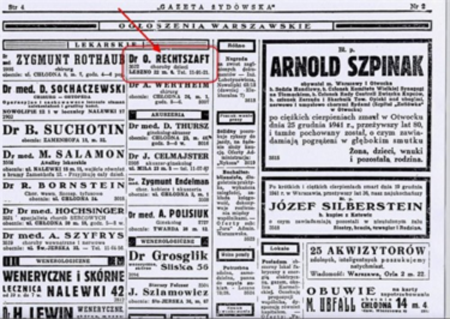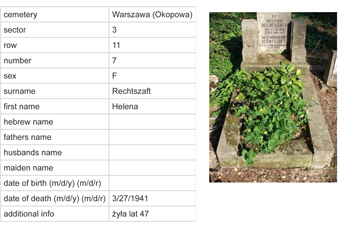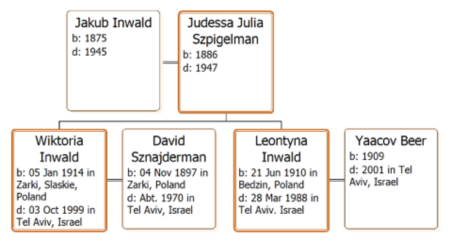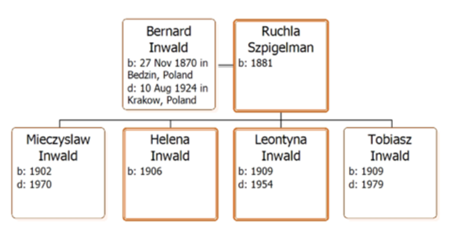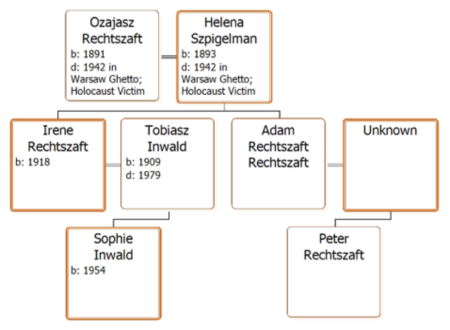Dawid Borejdo Sznajderman
Surviving hard times
WhatsNew:
Release October 16, 2022
Yigal used to write short chapters and read them at various events in the nursing home where he lived in the last years of his life.
The large and interesting part of the chapters are part of his life history.
Few are translations or abridgments of facts related to general education.
Release Feb 23, 2020
Berek Szczekacz and Chana Szmidt
Berek Szczekacz and Chana Szmidt had 12 children. Searching for Birth, Marriage, Death records (BMD) brings us occasionally to meet living family members. I admit, getting to know new blood related family members is the most exciting part of doing genealogy. Lately I met Yoram Shachar, one of Berek and Chana’s great, greatgrandchild about whom I haven’t heard until Dec 15, 2019. The meeting has prompted me to create pages for the descendants of Berek Szczekacz, our mutual great, great grandfather. The released page will introduce you to the 12 children and to their children. Currently there are only two documented stories, about Layzer Ludwig Szczekacz and about Frajdla Szczekacz. The stories about Yoram Shachar, Samuel Szczekacz (The artist, Shmuel Tzur), the many Shakter’s descendants and others will follow soon.
Release Nov 9, 2019
Yosef Kaluzynski and Chana nee Sznajderman
Release Jan 6, 2018
Fajgla Kaluzynski and Wolf Szperling

The Holocaust Had no Mercy for the Szperling Family
Stories and Photos
Release June 26, 20
A Telephone call from Australia to Californiaswept Jane and me into a research in the Czech Republic. Several families appeared for a moment and then disappeared during the Holocaust. Very few suvivors, many Yad Vashem testimony pages and research in the Czech Republic declared Jane, Dov Kuflik, his sister, Idit, and the five grandchildren of Josef Arieli, my self included, are 3rd cousins. Jane, Dov and his sister, Idit, are 2nd cousins.
Dawid Borejdo Sznajderman
The following story is about Dawid Sznajderman, the son of Abram Moshe Sznajderman and Ajdla Koenigsberg, who survived the tumultuous time of WWII.
Marek Kaluzynski was son of my great grandfather, Abram Kaluzynski, and his second wife, Chaja Dzialoszynska.
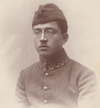
Marek’s mother, Chaja, died around 1912 in Czestochowa, leaving his father with five young children;
the youngest, Sara, was two years old. Marek was fourteen years old.
Release History
Important Links
Read the Beautiful translation by Jerrold Landau
Connect with Czestochowers all over the wold.
The World Society of
Czestochowa Jews
And Their Descendants
Family History
Memories, like sand stones
Slowly, a grain follows a grain,
Erode, crumble, and vanish.
Sea waves and wind
Sweep them away
Hurry
Listen to the voices
Collect the words,
The names, the episodes, the moments…
Carve and seal them
In a meticulously crafted pendant
Close to your heart
Allow them to live forever.
Let Us Start With Basic Steps:
Write down everything you know about yourself and about your family:
- Full names
- Date of Birth, Marriage and Death
- Where these events occured
- Talk to your grandparents, parents, uncles and aunts
- Write down family anecdotes
- Scan family photos
- Scan Family documents
Dawid Borejdo Sznajderman
Content
- 1 - IntroductionThe following story is about Dawid Sznajderman, the son of Abram Moshe Sznajderman and Ajdla Koenigsberg, who survived the tumultuous time of WWII. During the Holocaust Dawid lost his mother, wife, daughter, sisters and many relatives from his extended Koenigsberg family. He was the sole survivor of his immediate family. When I think about him, it always seems to me a miracle that he survived the Holocaust, became successful in Poland’s industry, and built a new family. It is a puzzle how he succeeded in contacting his extended family in France and Israel. The last known contact between the families of Abram Moshe Sznajderman with his family in Israel was in 1935 when my father, Ariel Arieli, visited his parents’ families in Poland and spent some time with them. The question of how families in general, and in particular, Dawid Sznajderman’s family, stayed in contact with families in other countries after the havoc of WWI and WWII remains a mystery my mind returns to often. While searching for evidence of contact between my families in Israel and in Poland, I found a booklet published in Israel after WWI with announcements from families who wished to notify their families abroad about themselves. In this booklet I found a message by my grandfather, Yosef Kaluzynski, to his father, Avraham Kaluzynski, in Czestochowa and to my grandmother’s father, Eliezer Sznajderman, in Zawiercie, announcing their wellbeing. |
- 2 - An announcement by my grandfather Yosef Kaluzynski in a small book published by the “Zionist Palestine Office.” My grandfather announced that he and his family were well.
|
- 3 - At the end of WWII, Israel's Radio setup a station with daily announcements of the Israeli residents searching relatives in Europe who might have survived the Holocaust. The name of the program was "Search Bureau for Missing Relatives" and it is still active today. A digitized site of Holocaust survivors exists in the Central Zionist Archives in Jerusalem, Israel. The site is not yet open to the public. There were also long lists of names in a special newspaper that was published by The Jewish Agency's Search Bureau for Missing Relatives after the war: הדים לקרוב ולרחוק "Echoes To the Close One and To the Remote One" The newspaper was published from June 1945 to 17 August 1947. The 73 issues of the newspaper (Lakarov V'larahok) include the names of well over 300,000 Holocaust survivors. The newspapers can be found in several archives in Israel and in New York . It was published by the Department for Missing Relatives of the Jewish Agency. The present index prepared by the Rabbi Shalom Bronstein.Rabbi Shalom Bronstein published an artice about the list of forgotten Survivors in the journal Avotaynu 1998 Volume 14, No 2. Until now I didn't have the chance to search the site or the papers for evidence of our relatives in Poland searching for their relatives in Israel or of my grandparents and their siblings searching for relatives that survived the Holocaust. With this turmoil as the background of the years after WWII, I will first lay out for you the miraculous waning and waxing contact between Dawid Sznajderman's family and the Sznajderman family in Israel. |
- 4 - 1957, IsraelIn 1957 Wiktoria nee Inwald, Dawid Sznajderman’s second wife, and one of their two sons, Tolek, travelled from Poland to visit the Sznajderman family in Israel.
|
- 7 - Tolek arrived from Germany to visit me in Sep 2001 in Palo Alto, and we spent a weekend together, talking non-stop. I remember the weather was good. We sat outside on a swinging bench next to the orange tree in our yard in Palo Alto, and Tolek told me about his father. He was sharing my enthusiasm in researching the family roots.
He extended the family tree to include his mother’s side, the family of Wiktoria Inwald. We both dived into the genealogy research. We were in touch by phone and by email almost weekly. Most of Tolek’s messages were short, through Ancestry.com, just telling me about his progress in adding leaves to the tree: |
- 8 - Shortly after Tolek visited me in Palo Alto, Julian, his brother, came to San Francisco for a conference and we met for the first time.
Julian Borejdo Sznajderman and Ruth Arieli Wilnai - San Francisco
|
Family Tree of Abraham Moshe Sznajderman

- 11 -Introduction to Dawid Sznajderman's FamilyAbram Moshe Sznajderman, Dawid’s father, was the son of Eliezer Sznajderman and Eigda nee Sztatler. Abraham had seven brothers and sisters. Abram Moshe Sznajderman stayed in Poland, got married with Ajdla Koenigsberg and the couple had had five children:
Sitting Right to Left: Abraham Moshe Sznajderman, his wife Adela Keonigsberg and one of their children, Yehudit Standing Right to Left: Maybe Sura/Saltza(?), Dawid, and Guta
|
- 12 - Abraham Moshe Children:
Abram Moshe Sznajderman, the father, died in 1938 in Zawiercie, Poland. He is buried in Zawiercie Cemetery alongside his father and mother and other Sznajderman relatives. Dawid Sznajderman Poland 1897
Zarki Synagogue (from Zarki Yizkor Book) |
- 13 - Dawid Sznajderman’s Birth CertificateBorn on November 4th, 1897 (October 21.1897 acc. to the Julian calendar) at 5:00 a.m.
|
- 14 - Looking at Koeningsberg family tree, I assume that Dawid was named after his mother’s grandfather, Dawid Koenigsberg, who died two years before his mother, Ajdla, was born. The birth record documents one of the witness’s’ names as Icyk Koeningsberg, and again looking at the family tree above, he might be Ajdla’s father, the newborn’s grandfather.
Looking at Adela Keoningsberg pedigree family tree above, I assume that Dawid was named after his mother’s grandfather, Dawid Koenigsberg, who died two years before his mother, Ajdla, was born. The birth record documents one of the witness’s’ names as Icyk Koeningsberg, and again looking at the family tree above, he might be Ajdla’s father, the newborn’s grandfather.
|
- 15 -High School and UniversityAt home, Dawid was nicknamed Witek - a common name in Poland.
|
- 16 - “When Witek (Dawid Sznajderman) studied in Bedzin he rented a room from my grandparents, Abram Perlmuter and Rywka Ursztejn.” Rena told me over the phone. Dawid graduated from high school on the 23th of June 1918. In November 1918 he joined the faculty of Mechanical Engineering at Warsaw University of Technology. WWI began on the 28th of July 1914 and lasted until the 11th of November 1918. Poland wasn’t an independent state during WWI. It was first partitioned in 1772, then a second time in 1793 and third time in 1795. In the third partition the Polish territory was split between Austro-Hungary, the German Empire and the Russian Empire. As a result of this partition when WWI commenced Poland was the scene of much of the operations in Eastern Europe during the war.
The map showing the third partition of Poland in 1795 and the territories taken over by Prussia (Germany) Austria and Russia. More information about the Historical Geography of Poland |
- 17 - Warsaw was occupied by the Germans from the 5th of August 1915 until 1918. The Germans wanted to gain the sympathy of the Poles and allowed the University of Warsaw and the Warsaw University of Technology to continue their instructions in the Polish language. The Warsaw University of Technology became the most important scientific center of engineering in Poland and gained international prestige. More detailed information the 1920 Polish-Russian war
In 1918 Poland reclaimed independence after 123 years of partitions. The Polish people didn’t enjoy the end of WWI for long. The Polish – Soviet war began in 1919. The space here is too short to tell all the war intrigues and actions. I will only reference an article unfolding the strategic details and the countries involved in it: Belarus, Lithuania, Poland, Galicia and Ukraine. The Bolshevik War 1919-1920 The Soviets considered the capture of Warsaw an important milestone for the benefit of the Soviets. They saw it as the imminent collapse of Poland. The Polish Army succeeded to break the siege on Warsaw and a peace treaty was signed in March 1921. These were years of devastation, hunger and poverty for the people in Poland.
During this time service in the military was compulsory, and Dawid Sznajderman was recruited and took part in the war. Dawid Sznajderman in military uniform. Maybe the photo was taken in 1920. The inscription on the back of the photo is blurred. There remains the question if we can we find evidence about being recruited to the Polish Army during the 1920 Polish-Russian war.
|
- 18 - Despite the conditions in Warsaw and his military service, Dawid Sznajderman studied and graduated from Poland’s top school in October (pazdziernik) 1927. Below is a Dawid’s class graduation photo. I examine the photo, the people and their dress, the professors sitting in in the first row where on both sides sits a person with a uniform. “Who are they” - I ask myself. Dawid is standing first on the left of the second row. I take a second look at the photo and a thought fly through my mind: “How did this photo survived WWII?”
|
- 21 - Dawid and Felicja’s first daughter, Regina Irena, was born in 1931 in Bedzin. Her first name Regina was given to her in memory of her grandmother, Regina-Rywka, but family members called her Renyutka. Irena Birth Record Details:
Irena Sznajderman - daughter of Dawid Sznajderman and Felicja nee Perlmuter
Painting of Irena Sznajderman. Rene Litoczeweski has the original photo. |
- 22 -
Irena Sznajderman, On her right maybe her grandfather Abram Perlmuter and on her left is her mother.
Rene Mailer (daughter of Maria Perlmuter, Felicja's sister) tells about the above photo that I’ve sent her: “Now I understand that the photograph of little Reniutka's face that I have is only a fragment of a bigger picture. Now I can clearly see that she is sitting in a big wicker chair, the kind used as protection against wind on cold Baltic beaches. My mother was always telling me about this wicker chair. I wonder whether she was there as well. In Europe Jews were stereotyped in a negative way for over 2000 years. Some stereotypes were defined by physical characteristics; the nose for example had served as a Jewish characteristic already in the 13th century. The negative stereotypes invoked anti-Semitism and reached a climax in the Third Reich during WWII. I remember, family members laughing about my grandfather’s nose. I was naïve and my grandfather was the most handsome man in the world in my opinion: “How could anyone ridicule him?” I couldn’t understand. Much was written in papers and articles about the stereotypes of the Jews.
|
- 23 -Dawid Sznajderman in Furstenberg FactorySometime after graduating from the university, Dawid worked in the Furstenberg Factory in Silesia as a mechanical engineer.
Searching for the Furstenberg Factory in Silesia, I found out that the book “A Memorial to the Jewish Community of Bedzin*” devotes a chapter to Szymon Furstenberg who started his adult life as an accountant and a request writer but slowly became a successful businessman. I quote from the chapter: “After the First World War, he (Szymon Furstenberg) bought a factory for metal production in Königshütten (upper Silesia), which prospered greatly. At this point, his fame began, and thanks to his untiring energy, organizational ability and initiative, he reached a very high level in Polish industry, as owner of the large zinc factory in Bedzin (Czeladzka Street) of which its production (zinc kalsomine, metal sheets, pails, etc.) was exported to foreign countries…. His enterprise employed more than one thousand people; many were Jews, especially in the management and executive roles. Some of them survived the Holocaust.”
This factory was the place where Dawid Sznajderman worked until the breakout of WWII. Furstenberg himself, shocked and horrified at the first events of WWII, fled with his family. He didn’t survive the war.
Bedzin |
- 24 - WWII – 1939 – The HolocaustGerman invaded Poland on 1 September 1939. Poland was attacked by the Soviet Union on 17 September 1939 and before the end of the month Poland was divided between the Germans and the Soviets. Large areas of western Poland were immediately annexed to Germany. These areas included the Katowice district where our Sznajderman ancestors lived for hundreds of years: Sosnowiec, Bedzin, Zawiercie, Olkusz, Pilica, Zarki and other towns. Persecution of the Jews by the Nazi occupation government began immediately after the occupation. The Germans executed innocent civilians from the very beginning of the war. It is estimated that 200 executions were carried out daily. In many of the towns there were indiscriminate executions by the Germans. Bedzin is among these towns. On September 4, 1939 the German army, followed by SS death squads, entered Bedzin. On September 8, the German SS death squads incinerated the Great Synagogue in the Old City and murdered 200 Jewish residents. Some members of the family said that Dawid’s wife, Felicja Sznajderman nee Perlmuter, and their eight-year-old daughter, Regina Irena, were shot during these first days. Friends saw them killed on the street. Another version of this painful story is that Felicja and Renyutka lived in the Bedzin Ghetto which was created in May 1942. When the German started the deportation of the Jews to Nazi concentration camps, Felicja and Renyutka ran away from the Ghetto to the Aryan side and were hiding there. One day, Renyutka played outside their living place. An SS police was walking along the street. One of the neighbors approached the Nazi soldier and said: “Do you see the young girl, she is Jewish.” The SS soldier killed her on the spot. There is a testimony to the last story in a book written by Wanda Duraj (W smudze czerwonych iskier. Wspomnienia - In a streak of red sparks. Memories) Wanda Duraj wasn’t Jewish, but her brother, Alexander Zawadzki (December 16, 1899 – August 7, 1964) , who was an important Polish Communist political figure and after the war became Poland’s head of state (1952-1964), was married to Stanislava, a first cousin of Felicja. Wanda Duraj in her book doesn’t refer to Felicja and Renyutka as Jewish and she doesn’t give names but Rena, Felicja’s niece, read the book and recognized it as the story that was told in the family. Until now I could not find the names of Felicja and Renyutka in any Bedzin’s victim list. One of the other sources is the “Holocaust Survivors and Victims Database” in the Unites States Holocaust Memorial Museum. It needs to be explored. No one in the family wrote a testimony page in Yad Vashem in memory of Felicja and Regina Irena Sznajderman. No one in the family added their name to the Bedzin Yizkor Book Necrology. But, I did find testimony pages in the memory of Adolf Perlmuter, Regina Perlmuter, Fela Perlmuter. The person who gave the testimony is Miriam Finkelsztejn who lived in Holon, Israel in the 1957. She signed the testimony as the niece of Adolf Perlmuter, another name for Abram Perlmuter.
|
- 25 -
Bedzin Synagogue 1910
|
- 26 - WWII – Soviet ArmyAt the outbreak of WWII, Dawid Sznajderman left Bedzin and went away from Poland to Russia. The circumstances of Dawid Sznajderman’s absence from Bedzin are not clear. Did he leave Bedzin because he was about to be recruited into the Polish Army? One theory states, that he reached the Soviet Union and was recruited into the Soviet army, participated in the war against the Germans. Dawid was wounded in a battle. If I am not mistaken he lost the sight in one of his eyes. While he was on the battlefield, he took the papers of another soldier who was killed next to him. Dawid Sznajderman returned to Poland with the Russian army through Katowice in 1945, probably when they liberated the town. Coming back to Poland, he learned that his wife and daughter are no longer among the living. Friends told him about their murder in the street four years ago. Dawid, I assume, was aware of the fate of the Jewish people during the war, and planned to return to Poland with different identity papers. There is a story among the family members that he took the identity of a soldier killed next to him in the battle, but a registration mistake occurred and the new name became Ignacy Borejdo, even though the killed soldier’s surname wasn’t Borejdo. (Tolek and I suspected that the real name of the killed soldier was not spelled ‘Borejdo’ as we couldn’t find a reference to such surname anywhere). Notes from several dates after WWII tell us about the name modification. It seems as Dawid took the trouble and went to the Zarki or Katowice town office to make the change. The whole story has some mysterious unresolved issues but reality says it all Dawid Sznajderman became Ignacy Borejdo. His grand-daughter, when I asked her in an email about her grandfather Dawid Sznajderman, didn’t know whom I am talking about. Searching for people with the surname Borejdo, I always get results only for people who are members of the Ignacy Borejdo family. I never have found or met any other person with the surname Borejdo. It is a fact that, in some way, supports the part of the story about registration mistake.
Note on the birth record margin (right): ...Katowicach z dnia 11. marca 1947 roku Nr. AP III/8-79/47 zapisany w tym akcie Dawid Sznajderman uzyskal zmiane imienia i nazwiska z "Dawid Sznajderman" na "Ignacy Borejdo". Zarki, dnia 29.07.1948 r. Urzednik Stanu Cywilnego: N. Jelen. Translation: ... Katowice of 11 March 1947 Ref. AP III/8-79/47 Dawid Sznajderman obtained the name change from "Dawid Sznajderman" to "Ignatius Borejdo". Zarki, dated 29.07.1948, the civil registrar N. Jelen. Note on the margin (left): ...narodowej w Katowicach z. dn. 16 kwietnia 1951r. Nr. S.A. III/32-12-154/50 uzupelnia sie zmiane nazwiska i imienia Borejdo Ignacy, imiona rodziców "Abram Moszek" i "Ajdla" na "Adam" i "Adela". Urzad St. cyw. Signature Zarki, 16 kwietnia 1951r. Translation …national in Katowice ... z dn. 16 April 1951. No.. SA III/32-12-154/50 August complements name change Borejdo Ignatius, parents' names "Abram Moszek" and "Ajdla" to "Abram" and "Adela". Office of St. cyw. Zarki, 16 April 1951
WWII Bedzin Synagogue in Flames |
- 27 - Felicja's SistersOne of the sisters was Maria Perlmuter (Bedzin, 1912 – Offenbach, Germany, 1986). Her nickname in the Borejdo’s family was aunt Manyusa. When I asked Rene, her daughter, how did her mother survived the Holocaust she told me briefly: “My mother was on a holiday with her then husband when the war broke out. He was recruited to the army and my mother travelled back to Bedzin to try to persuade her family to move east. Unfortunately she failed in that. She, with some friends, travelled to what became Soviet- occupied Eastern Poland's territories and stayed in town called Kovno where she taught biology at school. In 1941 they all moved to Russia proper.” The above few words leave many questions open: Whom did she try to convince to travel with her? Her father? Her two sisters and her niece? What happened to Maria’s husband? Where did Maria stay in Russia and how did she come back to Poland? I am not sure Rene has answers to all these questions. She concluded the WWII stories by saying: “My mother's very close friend whom she met after the war, was the only person still alive from their generation. Few years back I met up with her in Frankfurt hoping she would be able to shed some light on my mother's war years. Her reply was: we didn't talk about those times. Then she added; but if you want to know about my war experiences read the book written by Alina Margolis-Edelman.” Alina Margolis-Edelman (1922–2008), was the wife of Marek Edelman. They both survived Warsaw Ghetto. Marek Edelman was the last surviving leader of the Warsaw Ghetto uprising. Alina Margolis wrote a memoir about her painful experience in Warsaw Ghetto. The book wasn't translated to English. Maria escaped to Russia before the war ended. After the war she came back from Russia through Lublin. There she met her husband Julian Litoczeweski. Litoczeweski was not his original surname, but a surname he used after the war. They had a son, Jerzy (b. 1946), and a daughter Renyutka-Irena, now Rene (B. 1949), named after Felicja’s daughter who was killed at the outbreak of WWII.
|
- 28 - Rene told me in her letter: “I was named after Ranyutka and my parents called me Ranyutka, my friends called me Ranyutka. Witek adored me.” Renyutka, now calling herself Rena, married and has two daughters. They all live in London. Jerzy and his mother lived in Germany. Manyusa passed away in Germany in 1986. She was 74 years old. Jerzy is still living today. The father, Julian Litoczewski, died in Tel Aviv, Israel in 1979. He was 71 years old. Rena told me - “My mother didn’t talk about the war but here and there she liked to tell short anecdotes about the life before the war.” A few minutes later she said: After the war my mother took the train from Warsaw to Bedzin. At Bedzin’s train station she spoke with someone and told him that she came to see her home. “Don’t go, there is nothing there.” The man said. She didn’t go, she stood the whole night at the train station and in the morning she took a train back to Warsaw The fate of the second sister, Nusia Perlmuter, remains a mystery. She studied music in Vienna and got married there, but never had children. Like her sisters and like Witek she was also a communist. Like Maria she wanted them all to escape to Russia when the war started. I haven’t succeeded to find anyone who knows about her fate. Rene, her niece, thinks that she didn’t survive the Holocaust.
Julian Litoczewski and his wife Maria nee Perlmuter
|
- 29 - The site CENTROPA has a short exciting story about Maria Perlmuter and two more photos. The story is taken from interview of her friend Apolonia Starzec. The interview was held in Warsaw, Poland 2006 by Martha Cobel-Tokarska. Apolonia Starzec told the interviewer about her friend Marysia Litoczewska, nee Perlmuter: Marysia was my friend from the student period in Cracow, she studied biology, I did chemistry. She came from Bedzin. We bumped into each other accidentally after the war. We were applying for a job somewhere, she had been in the First Army. Married name Litoczewska, maiden name Perlmuter. Marysia. We called her Maniusia. She was so petit, so slim, always smartly dressed. And when I met her, right after the war, she approached me, in uniform, she looked like a bag with a piece of rope wrapped around her waist, so round she was. It wasn't the same Marysia, I didn't recognize her at first. And so, from word to word, we moved in together. A rented room, in Praga. We also got married on the same day: 1st October, my birthday. 1944. Soon afterwards she emigrated with her husband to Israel. They have two kids, the girl lives in England, the boy in Germany.
Maria Litoczewski, her husband and their two children, Warsaw, late 1940s
|
- 30 -
Sitting in the middle Maria Litoczewska, hugging her on the left Apolonia Starzec. On the right: Mirka Bidowa The man behind Apolonia is Maria's husband, Julian Litoczewski Maria Perlmuter and Julian LitoCewski |
- 31 - Poland 1946-1968Dawid Sznajderman, under his new identity of Ignacy Borejdo, returned to Poland. He was awarded, in 1946, the Poland Gold Cross of Merit. Displayed below is an image of the newspaper from 1946 with the lists of people who got the Cross of Merit award immediately after the war. The Cross of Merit is a Polish civil state award established in 23 June 1923 to recognize services to the state. The Gold Cross of Merit is the highest grade. I assume Ignacy Borejdo got this notable award for an accomplishment during his WWII military career. Ignacy Borejdo started to work in the Polish industry in the city of Katowice. Alexander Zawadzki, was the man who helped Ignacy Borejdo to be active in the Polish government and to reach a high post within it. Alexander Zawadzki (b. Dec 16, 1899 - d. Agust 7, 1964) was an important Polish communist political fugure and had a long list of important roles in many Polish organization.He was the head of state of Poland from 1952 to 1964. Ignacy Borejdo, is considered to be the man who restored the Polish industry in Silesiaa region rich in minerals and natural resources. Katowice is one of the several large cities in the region. Ignacy Borejdo, in his new life, met Wiktoria Inwald, married her and together they had two sons. Wiktoria was more open about her life during the Holocaust and she told Tolek about events that happened to her and to the people she met. Wiktoria’s life is a chapter by itself.
|
- 32 - Wiktoria Inwald - Dawid Sznajderman’s Second WifeWiktoria was born on January 5th 1914 into a well-known, wealthy family in Bedzin, Poland. Her father, Jacob Inwald, was a co-owner of a factory producing zinc white (zinc oxide) for paint sheets and later branched out into galvanizing roofing sheets. The Inwald’s factory, Fabryka Bieli cynkowej, in Bedzin, Poland, was named “Leontyna” after Leontyna Inwald, one of the Inwald’s ancestors. The Polish Wikipedia includes references to the Inwald factory in 1898 and in 1906. Between September 1929 and June 1931, Wiktoria studied at an all Girls’ High School (Gimnazjum żeńskie), of Helena Rzadkiewicz, on Dęblińska 1 street, in Sosnowiec, Poland. She obtained her matriculation on the 22nd of June, 1931. After her matriculation she left for Reims, France, where she studied physics, chemistry and natural sciences. In September 1933 she returned to Poland, and until September 1936 she studied at a Commercial College (SGH) in Warsaw. From the autumn of 1936 until July 1939, she worked at “Dom Handlowy A. Gepner”, Warsaw, Grzybowska Street 27, as a foreign language secretary. Today in the world of the internet sometime one can find some proof for the existence of a person or an event. It is one of my passions to try to search and find some evidence for the past and indeed I did find an old advertisement for the company where Wiktoria worked:
In 1939 she married Bronek Cukierman. Wiktoria’s family was not happy about Bronek, considered by the family to be a man who was not ready to work hard for his living. Wiktoria’s parents, the Inwalds, bought him a factory, named Młot, in Krakow, so he could earn a living. This period ended quickly with the onset of WWII. Bronek was recruited into the Polish Army and later was a prisoner of war. He wrote letters to Wiktoria under the name Cukrowski. This last comment has many questions marks. How long were they in contact during the war? As we continue our story, we’ll see from Wiktoria’s life during the war that she was always moving and hiding. It is difficult to believe that there was a steady flow of letters between people who moved in the battlefield to people who were trying to survive in the Ghetto. Wiktoria spent the war years in Warsaw. In October 1940 she had to move into the Ghetto. She lived on Leszno 22 Street, app. 6 together with the family of Dr. Med. Ozajasz Rechtschaft. In the Ghetto of Warsaw there were thousands of medical doctors and nurses. (We should Try to search the name of Dr. Med. Ozajasz Rechtschaft in the book “The Warsaw Ghetto: A Guide to the Perished City.” Wiktoria and her beloved cousin Tadeusz (Tobias) Inwald stayed in the Warsaw ghetto with Dr. Ozajasz Rechtszaft until Wiktoria escaped the Ghetto in September 1942. Later Tadeusz Inwald married Dr. Rechtszaft’s daughter, Irena.
|
- 33 - During the final phases of Wiktoria’s stay in Warsaw Ghetto she was in the “small ghetto”. She worked in Walter Többens Company – a textile factory. Walter Többens was the largest employer in the Warsaw Ghetto. Többens employed mainly women, typically as tailors. The book “The Warsaw Ghetto: A Guide to the Perished City” lists the production plants and “Shops” in the Warsaw Ghetto. Among them we can find the Walter Többens shop where they produced uniforms, military overcoats and mackintoshes, caps, furs, leather goods and underwear. After the Warsaw Ghetto uprising in May 1943, 10,000 workers were shot to death in a factory that Többens established in Poinatowa labor camp near Lublin. According to “Memoir of a Warsaw Ghetto Fighter” by Simhah Rotem In 1946 Walter Caspar Tobbens escaped from a train extraditing him to Poland to be tried for war crimes. Wiktoria escaped from the Umschlagplatz collection point, a square in the Warsaw Ghetto where the Jews were gathered for deportation to “Teblinka” extermination camp as part of Operation Reinhard. It was located on Stawki Street. She succeeded in escaping with the help of a Jewish doctor who gave her his white coat and claimed that she was a registered nurse who worked for him at a hospital. She escaped the Warsaw ghetto in September 1942 together with a group of Többens’ workers and was arrested by the Polish police (so called “granatowa policja” - The Navy Blue Police – the popular name of the Polish Police in the German occupied area during WII). Again, she escaped from the police station by saying that she would supply a ransom but then never returned. Until January 1943 she stayed in żoliborz, ZAUŁEK Street 1, with the family Zarembski. Zoliborz, the Sub-district II of Żoliborz - a territorial organisational unit of the District of Warsaw of Armia Krajowa.It covered the area of Żoliborz in Warsaw fought in conspiracy during the German occupation f Poland during WWII and openly during theWarsaw uprising 1944. Zarembski Family – Seaching the web I found a reference to Sam Zamrembski who participated in the Warsaw Ghetto uprising. It still has to be verified as the same Zarembski family referenced in Wiktoria’s story Wiktoria obtained a Polish (Aryan) birth and christening certificate as Wiktoria Iłowicka, born in Równe on 2nd June, 1917. In January 1943 she moved to Milanówek, an independent administration in the wider Warsaw City. She worked as a nurse for the Wilczkowiak family, in the house named “LASZKA”, Krasinskiego 24 street.
Wiktoria in Milanowek. She was a Nanny to the girl that she is holding. She also took care of a baby boy who was recently born. She remained with the family until the end of the war. Wiktoria helped this family after the war in many ways. When she emigrated to Israel she brought the mother of the family to Israel twice for prolonged visits. Julian has written to Yad Vashem with the intention of making the matriarch of the family a Righteous Gentile but their requests of proof and documentation were so massive and impossible to supply that he gave up. Recently, June 30, 2017, I found that the "boy" name is Wieslaw Wilczkowiak.
|
- 34 - Obviously a German officer fell in love with her. Unfortunately a comrade denounced her to the Gestapo, and in January 1944 she was arrested in Milanówek by the Gestapo and taken to Aleja Szucha 25 , Warsaw – the headquarters of the Gestapo, where she awaited her death sentence for three days and two nights. She was released thanks to help of that German soldier, who apparently also fall in love with her in Milanówek, and also because, at the end of the day, the Germans believed in her Aryan papers. The US$200 that she owned also helped in her release. The 'United States Holocaust Memorial Museum" has a collection of poems written in Warsaw Ghetto for Wictoria by a judge she befriended in the Ghetto. The first poem is hand written, housed in a small green notebook cover. The second poem, or series of poems, is type-written on nine pages. The collection was donated to the United States Holocaust Memorial Museum by Julian Borejdo in 2000. After that, she hid in żoliborz again, this time with a soldier’s family, Kwieciński, SUŁKOWSKIEGO Street 2. The stories about how the Kwieciński family provided living space and food for many Jews appear in the book “Kwiecinski Family. They were just people: Stories of Rescue in Poland During the Holocaust By Bill Tammeus, and Jacques Cukierkorn." The story in the book is told by Andre Nowacki who was saved by the Kwiecinski family. During the Warsaw Uprising by the Polish resistance movement, 1 August, 1944 – 2 October, 1944, Wiktoria was a hospital nurse. She was wounded in the face and hands and was taken to the hospital on śmiała Street. The Warsaw Uprising failed and the Polish resistance surrendered after 63 days. The German deported about 650,000 Warsaw residents to Durchgangslager 121 (Dulag 121), a transit camp in Pruszków set up especially for this purpose. Wiktoria was among those residents who passed through Pruszków. She escaped the camp and was hiding in the village, Wólka Kossowska, about 21 km southwest of Warsaw with a peasant’s family, named Kostan. There she survived until the end of WWII. I tried to find information about this village during October 1944. The only hint I found was that among the Polish insurgents were people who were born in Wólka Kossowska. In February 1945 Wiktoria took one of the first available trains and returned to Katowice, close to her family home in Bedzin. In the outbreak of WWII, Wiktoria’s family, the Inwalds, escaped to Russia. Stalin evacuated thousands of Russian Jews to Uzbekistan, and among them the Inwald were also deported to Sibiria. Wiktoria's father, Jakub Inwald, died in 1945, in Bukhara, Piechotnyi Pereulok 5, Russia. Bukhara was the smallest Jewish center among the tree major Jewish centers in Uzbekistan. Wiktoria's mother, Judessa Julia nee Szpiegelman, came back to Katowice, Poland, and died there on 11 November 1947. Tolek was about two years old when his grandmother passed away in Bedzin.
Wiktoria’s eldest sister, Leontyna Inwald, survived the Holocaust. She immigrated to Israel and died there in 1988. Her grandchildren are living today in Israel. As you can see, Wiktoria told her son Tolek about her hardship and survival through the years of the Holocaust. However, we know almost nothing about Ignacy Borejdo’s troubled years during WWII.
The Inwald Home in Bedzin before WWII
|
- 35 -Dawid Sznajderman and Wiktoria InwaldWiktoria Inwald and Dawid Sznajderman knew one another before WWII. As you recall Wiktoria was married before the war to Bronek Cukierman. The couple didn’t have children. Coming back to Bedzin in February 1945, Wiktoria didn’t find her husband in Bedzin or in Katowice. Wiktoria probably assumed that Bronek, like so many other who didn’t come back, was murdered in the Holocaust. Wiktoria met Ignacy Borejdo again after the war when she came to his office for some kind of help with transportation. Julian their son added: "I know that my father arranged a truck to bring Mom’s parents back from Russia (Buchara) to Poland." Soon Ignacy and Wiktoria Inwald were living together. Their eldest son Tolek was born in Katowice on 17 January 1946, and only then did they get married. The war continued to influence the fate of Wiktoria and Ignacy even when the fire of the guns was extinguished. Wikoria’s first husband, Bronek, returned to Bedzin and found out that Wiktoria had already married Ignacy Borejdo and had her first son, Tolek. I imagined the meeting, the disappointment and shock, but Tolek told me the story as a matter of fact, without emotion, and ended with the short statement: “Bronek had only one option, he divorced Wiktoria.” Ignacy and Wiktoria soon had a second son, Julian, who was born on 03 November 1948 in Katowice. The family lived in Katowicz until 1952.
Julian and Tolek Sznajderman The way Tolek told me about his family reflected the character of the Polish Jews. Polish Jews are always secretive about the facts of life. The motto was that children shouldn’t be exposed to family events, whether the information was bad or good. Every piece of news, every move and every family decision was a secret. I’ve experienced this behavior in my Polish family as well. The grownups never talked to us, the children, about serious issues. They never shared any facts or news with us. The short expression, “you are Polish”, is used even among Jewish people who weren’t born in Poland to express reserved manners. When Tolek was about seven years old, the family took a vacation, and at the end of the vacation, they didn’t return to Katowice, instead moved to Warsaw.
|
- 36 - Ignacy Borejdo became a minister of heavy industry in the government of Alexander Zawadzki. Wiktoria, who spoke several languages, worked for the head of the mining industry. Ignacy Borejdo wrote a book about his expertise in Metallurgy: “Hutnictwo w Planie sześcioletnim (Metallurgical Plan for Six Years)”. Ignacy and Wiktoria lived a relatively bourgeois life in poor, Communist Poland. They had a car and a relatively large apartment. I will return for a moment to the question of the contact between the family in Poland and the family in France and in Israel. Ignacy’s youngest brother, Maurice Sznajderman, left Poland between WWI and WWII. He ended up living in France. During the war he lived with his family in a small village and thus survived the Holocaust. At the end of the war, he moved to Paris where his children are still living. I asked Maurice’s son, Stephane Sznajderman: “How did your father, Maurice, find his brother, Ignacy, after the war? How did they remain in contact?” “I don't know how the two brothers found one another,” Stephane answered. “I just remember that my father flew, maybe twice, to Poland to meet his brother. It was during the 1950s. I was very young. When he came back, I just remember a large box of "caviar". It was a present from his brother.” Caviar was a symbol of luxury in those days. Then I remembered that when I first met Stephane in Paris, about three years ago, he said something about meeting the Borejdo family in Poland and I asked him again about it. “Do you remember your family visiting the Borejdo family in Poland?” “I am sorry, I don't remember clearly the meeting in Warsaw,” Stephane replied. “I was too young. I only remember that the apartment was large and was located in a very nice area of Warsaw. It was at the beginning of the sixties. The Borejdo family lived like "bourgeoisie" in a poor Communist country.” Ignacy and Wiktoria Borejdo did not emphasize their Jewishness among their many friends in Warsaw who were both Jews and gentiles. Most of Tolek's friends, however, were Jews. Many of them still live today in Poland. The family did not celebrate the Jewish holidays, but they did celebrate birthdays, unlike the Polish who celebrate name days. Tolek and his brother were not aware of the Jewish problem until 1957 when they came for a visit to Israel, but even then it did not change their lives. There are documents telling the stories of Polish families, like the Borejdo family, who were communist families, grew up in a privileged milieu, in which it was known who was Jewish, but it wasn’t manifested. Most of the Jewish people left Poland in 1968.
Dawid Sznajderman and Wiktoria nee Inwald |
- 37 - When Wiktoria and Tolek returned to Poland from their visit in Israel, Ignacy Borejdo wrote a letter to my grandfather, Josef Kaluzynski. Warszawa 1/4/57
My Dear uncle, aunt, Igal, Ariel, and the rest of the family! I can’t even imagine how happy I was when I’ve learned that you are healthy, that you are doing well, and that almost all of you are together. From all of our quite numerous families [members] in Poland, I’m the only one alive. All of the others have died in the Nazi camps. It is hard to imagine the nightmare which I’ve endured. During the war I’ve lost my eye, but it is not affecting my work. I got left with devastated nerves. I think that I’m writing to you for the first time in my life. Before the war, as far as I remember, only my mother (Ajdla Sznajderman nee Koenigsberg) was writing to you. From all of you, I have only a foggy picture of my aunt Hana, when she came to us for a visit [in about 1910] [Hana and her husband Yosef Kaluzynski lived at that time in Beirut, Lebanon]. It took place during the war between the Turks and Italians. The newspapers were informing us that the Italian Navy was bombing Beirut, and auntie was worrying if anything had happened to uncle and, of course, she was homesick. I remember when she stood by the window, with her forehead against the glass, looking for good news, and she cried. After that I also remember when she left, and she wanted to take me with her, but unfortunately she didn’t. I do remember Ariel very well because he has visited us before the war. My family and I were on vacation in Poronin and he had come to us. I do remember how much he had admired the operetta Rose-Marie, which he had seen in Warszawa. What a terrible suffering is parting us from these times. I know that you have had also hard times, but at least you didn’t have to face the Nazis. My biggest desire right now is to see all of you. I strongly believe that I will be able to come to you. My wife and son were telling me how beautiful (it) is there. I sincerely thank you for the hospitality that you have shown to her. She talks about you very often, and Tolus would like to play again with Igal’s son. I will not talk about myself; my wife probably has told you everything about me. Write to me something about yourself. I would like to thank my uncle for the information about the family. I didn’t know anything about them. I don’t remember uncle David (Sznajderman). I can’t recall how he looked, but I do remember that he was a good drawer, or even painter. I do remember that in the grandma’s room [Eigda Sznajderman nee Sztatler], above her bed, was a big picture of Gorki, the writer, which was painted as far as I know by uncle David. I also remember, but only from grandma’s tales, that in Zawiercie, by the Blanowska St., hooligans had stabbed Uncle David with knives. I wonder if he remembers that. I’m expecting from you a long letter. You can write to me in English or French, unfortunately nobody over here knows how to read Hebrew. Uncle can still write in relatively good Polish, so you can write to us in whatever you like. I would like to say good bye to you. I’m kissing every one of you, hard and sincerely, and especially auntie Hana, because she was the only one in the family whom I’ve loved very much. Yours David.
“Dear Debora and all the family, I thank you for kindness you have given us and I hope we will see you in a short time. All the best Wictoria.”
Dawid Sznajderman Borejdo
|
- 38 - Poland 1968The life of Ignacy Borejdos’ family changed on March 8, 1968. On this date Poland experienced a political crisis. Many students and intellectuals protested against the government of the People's Republic of Poland. The crisis resulted in the suppression of student strikes by security forces in all major academic centers across the country and the subsequent repression of the Polish dissident movement. It was also accompanied by a mass emigration following the anti-Semitic, "anti-Zionist" campaign waged by the Minister of Interior, Gen. Mieczysław Moczar, with the approval of the Communist Party General Secretary Władysław Gomułka. The government's anti-Jewish campaign had already begun in 1967. It was a policy carried out in conjunction with the Soviet withdrawal of all diplomatic relations with Israel after the Six-Day War. Factory workers across Poland were forced to publicly denounce Zionism. There was also a power struggle within the Communist party itself. The subsequent purges within the Communist party, led by Mieczysław Moczar and his faction, resulted in an actual expulsion from Poland of thousands of individuals of Jewish ancestry, including professionals, party officials and the secret police functionaries blamed "for a major part, if not all, of the crimes and horrors of the Stalinist period." Before the end of 1971, 12,927 Poles of Jewish origin emigrated. The Jewish Poles left Poland and the emigration had automatically deprived them of their Polish citizenship. Their official destination was Israel, but in fact they were accepted by other countries in Europe and the USA. Ignacy Borejdo had already been out of the government due to health problems. He retired from his government post in 1965. He was very sick with Parkinson’s disease for many years. He had difficulty speaking. Years before, in approximately 1960, he went to Sweden for an operation. In 1968 Tolek, Ignacy’s oldest son, was a student and wanted to complete his studies and work towards a Diploma as was required in Poland. Unfortunately he was asked to leave the university and to complete his studies in Israel. In September 1968, Ignacy, Wiktoria and their two sons left Poland presumably for a vacation, but instead moved to Israel. By the time Ignacy Borejdo reached Israel, his health had deteriorated and most of the time he was not aware of where he was. The family lived in Holon, Ramat Hanasi. The family of Aunt Manyusza Perlmuter (sister of Ignacy Borejdo’s first wife) left Poland with the Borejdo family and lived close by in Holon. Tolek emphasized the sad fact about his father’s death: “Aunt Manyusza came to visit my father when he was hospitalized in Israel, and she was the person who found him dead.” Ignacy died in Israel in 1970 and was buried in HOLON cemetery. The location of his grave: Gush 2, Ezor 6, Shura 36. Julian Borejdo, the youngest son, did not emigrate from Poland with his parents to Israel instead they decided that he would go to Australia. Julian went to Italy and stayed there for almost half a year in HIAS camp waiting for a Visa to Australia.In Australia Julian met his wife, Judith Murray, and only later did they come to Israel. Tolek left Israel in September 1971. He lived in Germany until his sudden death in 2012. After the death of Ignacy Borejdo, Wiktoria remarried. Currently I have no information about her life with her third husband. The emigration from Poland was a painful process for the Borejdo family. Tolek spoke about it openly and later when I came to know other relatives, as you’ll see in the next chapter, they also raised this unhappy chapter in the Borejdo family life.
Wiktoria Sznajderman nee Inwald
|
- 39 - Dr. Med. Ozajasz RechtschaftThe Rechtszaft family lived in Bedzin before WWII. Bedzin 1939 Census tells us that Helena Rechtszaft (b. 4 May 1893)and her daughter Irena Rechtszaft (b. 17 May 1918) lived with the head of the family in Bedzin on Beuthenerstr. 33/ Kollataja, the family number was 587, page 706 list 15376 and 15377. Dr. Ozajasz Rechtszaft served as a medical doctor in Warsaw Ghetto. Tolek Borejdo found an advertisement in a Jewish News paper that was issued in Warsaw Ghetto.
Searching Yad Vashem I found a testimony pages for Dr. Rechtszaft Ozajasz and his wife. The testimony pages were given in 1976 by their son, Adam Rechniewski, living in Australia. 'Dr. Ozjasz Rechtszaft was born in Lublin, Poland in 1891. Prior to WWII he lived in Będzin, Poland. During the war he was in Warszawa, Poland. Dr. Rechtszaft was murdered/perished in 1942 in the Shoah. This information is based on a Page of Testimony (displayed on left) submitted by his son.' 'His wife, Helena Rechtszaft nee Szpigelman was born in 1893 to Mirla (her mother). She was married to SZpigleman. Prior to WWII she lived in Będzin, Poland. During the war she was in Warsaw, Poland. Helena was murdered/perished in 1942 in Warsaw, Poland. This information is based on a Page of Testimony submitted by her son Adam Rechniewski, Australia.' Among Warszawa Ghetto Deaths I found the following data: Helena Rechtszaft died on 27 March 1941 in Warsaw. The cause of death was pneumonia. She was 47 years old.
Her granddaughter Sophie Inwald added: “Helena Rechtszaft, my grandmother, died in 1941, in Warsaw Ghetto,probably of pneumonia for which the doctors in the Ghetto couldn’t obtain the appropriate medicine So, I learned that Dr Ozajasz Rechtszaft and his wife Helena perished in the Holocaust." The testimony of Adam Rechniewski was dated 1976. His address was registered in Sydney Australia. Helena's tombstone is in Warsaw Cemetery.
The photo of theHelena's grave stone was found in the Database of the Jewish Cemeteries in Poland.
Searching Google I soon encounter the email of Liz Rechniewski - elizabeth.rechniewski@sydney.edu.au Soon, I typed the following message: “Dear Elizabeth! I will first introduce myself: My name is Ruth Wilnai. I live in the USA. I am researching my family history in Poland and Belarus. I am currently writing about Wiktoria Inwald who lived in Warsaw Ghetto with the family of Dr. Rechtszaft. I saw in YadVashem a testimony page by Adam Rechtszaft about his father. Are you related to them? If yes, I would like very much to talk with you. Hope to hear from you. Ruth Wilnai.” |
- 40 - Elizabeth’s reply was fast: “Dear Ruth I am married to Peter Rechniewski, Adam's son. I have told him about your email and forwarded it to him (his email address is poljazz@wix.com.au) and he is delighted to hear that you are working on this and will, I know, give you as much information as he can. His cousin Sophie Inwald is the daughter of Irena Inwald (his aunt of course) who escaped from the Warsaw ghetto and is still alive and living in the Montefiore home in Sydney. She is still well able to talk about her past and has been interviewed on radio. Let me know if I can help you in any other way, but you will probably find it more useful to contact Peter and Sophie directly (Sophie's email is: Sophie Inwald [inwalds@tpg.com.au] Best regards Liz Rechniewski”
Tolek invested days researching the Inwald family and building a family tree. The Inwald family was a large wealthy family. There were many descendants and then the descendants had many more descendants and it went on and on until the Holocaust days arrived. The Inwald are not blood related to me and I never thought about adding them to my family tree, but now curiosity overcame my idea about trying to limit the family tree to blood related relatives. I started adding Inwalds to my family tree. Wiktoria’s father, Jakub Inwald, had eleven brothers and sisters. I will not display here the full tree, only the branches of two brothers that are relevant to our story, Jakub and Bernard. At this point I would like to add that the two brothers Jakub and Bernard married two sisters Judessa Julia and Ruchla Szpigelman Jakub Inwald’s branch includes his two daughters Wiktoria and Leontyna.
Jakub Inwald branch
Bernard Inwald’s branch: Bernard Inwald married Ruchla Szpigleman and they had four children: Mieczyslaw, Helena, Leontyna and Tobiasz.
Bernard Inwald Branch
|
- 41 - Let us return for a moment to Dr. Rechszaft. He and his wife had two children: Irene and Adam. The children survived the Holocaust.
The link between the Rechtszaft family and the Inwald family was strengthened after WWII with the marriage of Bernard Inwald’s son, Tobiasz Inwald, and Irene Rechtszaft, Dr. Ozajasz Rechtszaft’s daughter. The couple’s daughter, Sophie, was born in Poland. To get a closer look through the tangle of branches we can scroll back to the two branches of Jakub and Bernard Inwald and we’ll see that Wiktoria Inwald and Tobiasz Inwald are first cousins. They were ‘double’ cousins as their mothers (Judessa Julia Szpigelman and Ruchla Szpigelman) were sisters and their fathers (Jakub Inwald and Bernard Inwald) were brothers. Tobiasz Inwald and Irene Rechszaft with their daughter immigrated to Australia in 1957. Irene’s brother, Adam, married Janina and they had a son, Peter. Adam’s family immigrated together with his sister to Australia. They immigrated to Australia because they already had other relatives there who sponsored both families. Lis made a contact between Sophie Inwald and me. It is a pleasure for me to communicate with her. Sophie saw the Borejdo family from the other side of the world. When Tolek told me about his parents he did tell me about his father’s, Ignacy Borejdo, success in Poland’s government but he neglected to emphasize his father’s role in the Communist government in Poland. Today from the very few facts and notes I know about him, I think I can conclude that being Communist was an important part of his personality. |
- 42 - As I’ve already told you before The Borejdo family was forced to leave Poland in 1968. Their immigration path to Israel was paved with rough stones. The family split. Tolek immigrated with his parents to Israel. The family didn’t have any obstacle entering Israel. Israel, according to the Law of Return, accepted them. The parents persuaded Julian, then only twenty years old, to immigrate to Australia. The assumption is that for Ignacy Borejdo it wasn’t easy to get a visa to Australia because of his physical health issues. Julian lived in Australia with the Rechtszaft family. Sophie remembers Julian’s unhappy experience in Australia. When Julian left Australia his contact with the Rectszaft family ended. When I think about him, I have an empathy for him. He was uprooted from his home country, Poland, where he lived relatively wealthy life with his family. He was torn apart from his parents and had to start new life all by himself in a foreign country. It can be a traumatic event. There are documents about the experience of other Jewish immigrants from Poland at the same period of time that also went through difficult time because they didn’t want to come to the new country. They simply hated everything. Sophie tells warmly about Wiktoria, Julian’s mother: “My mother Irena Inwald, was in the Warsaw Ghetto with Wiktoria, and they both worked in the ‘Sztuka’ Café, on Leszno street in the little Ghetto”where Władysław Spillman played the piano. This is the coffee Shop that features in the Roman Polanski film ‘The Pianist.’ (Władysław Szpilman The protagonist in book and the movie.) When I was younger, I used to hear many stories and anecdotes about Wiktoria as my father was especially fond of her. I kept in touch with Wiktoria by letters and I met her when she visited Australia and I have strong recollections of her – she was a charming and beautiful woman even in her later years.” But then she added: “Wiktoria never fully came to terms with having to live there (in Israel) – or at least that was what she told us.” Wiktoria’s story, as she told it to Tolek, goes by briefly, without going into detailed descriptions over her hardship during the Holocaust years. On the other end, Irene Inwald nee Rechtszaft was interviewed by volunteers from the USCShoah Foundation, A project initiated by Szpilberg Foundation. I wonder if Irene’s testimony will also shed light on Wiktoria’s suffering in the Ghetto. The interview was conducted in Sydney, Australia. The testimony video is not viewable online. It can be viewed in Stanford Green Library.
|
